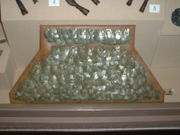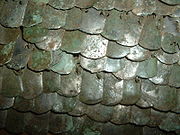
Lorica squamata
Encyclopedia


Scale armour
Scale armour is an early form of armour sometimes erroneously called scale mail consisting of many individual small armour scales of various shapes attached to each other and to a backing of cloth or leather in overlapping rows. Scale armour was worn by warriors of many different cultures as well...
used by the ancient Roman military
Roman army
The Roman army is the generic term for the terrestrial armed forces deployed by the kingdom of Rome , the Roman Republic , the Roman Empire and its successor, the Byzantine empire...
during the Roman Republic
Roman Republic
The Roman Republic was the period of the ancient Roman civilization where the government operated as a republic. It began with the overthrow of the Roman monarchy, traditionally dated around 508 BC, and its replacement by a government headed by two consuls, elected annually by the citizens and...
and at later periods. It was made from small metal scales sewn to a fabric backing. It is typically seen on depictions of standard bearers, musicians, centurion
Centurion
A centurion was a professional officer of the Roman army .Centurion may also refer to:-Military:* Centurion tank, British battle tank* HMS Centurion, name of several ships and a shore base of the British Royal Navy...
s, cavalry
Cavalry
Cavalry or horsemen were soldiers or warriors who fought mounted on horseback. Cavalry were historically the third oldest and the most mobile of the combat arms...
troops, and even auxiliary infantry, as well as regular legionaries
Legionary
The Roman legionary was a professional soldier of the Roman army after the Marian reforms of 107 BC. Legionaries had to be Roman citizens under the age of 45. They enlisted in a legion for twenty-five years of service, a change from the early practice of enlisting only for a campaign...
. The historically accurate Roman victory triumph depicting Trajan's victory over the Dacians, the Tropaeum Traiani
Tropaeum Traiani
The Tropaeum Traiani is a monument in Roman Civitas Tropaensium , built in 109 in then Moesia Inferior, to commemorate Roman Emperor Trajan's victory over the Dacians, in 102, in the Battle of Tapae. The monument was erected on the place where legio XXI Rapax had previously been defeated in 92...
, shows the majority of legionaires wearing lorica squamata. A shirt of scale armour was shaped in the same way as a mail lorica hamata
Lorica hamata
The lorica hamata is a type of mail armour used by the Roman Republic and the Roman Empire. During the 1st century it was starting to be supplemented by lorica segmentata, but had been reintroduced as sole standard-issue armor by the 4th century. It was issued for both primary Legionary and...
, mid-thigh length with the shoulder doublings or cape.
The individual scales (squamae) were either iron
Iron
Iron is a chemical element with the symbol Fe and atomic number 26. It is a metal in the first transition series. It is the most common element forming the planet Earth as a whole, forming much of Earth's outer and inner core. It is the fourth most common element in the Earth's crust...
or bronze
Bronze
Bronze is a metal alloy consisting primarily of copper, usually with tin as the main additive. It is hard and brittle, and it was particularly significant in antiquity, so much so that the Bronze Age was named after the metal...
, or even alternating metals on the same shirt. They could be tinned as well, one surviving fragment showing bronze scales that were alternately tinned and plain. The metal was generally not very thick, 0.50 mm to 0.80 mm (.020" to .032") perhaps being a common range. Since the scales overlapped in every direction, however, the multiple layers gave good protection. The size ranged from as small as 6.3 mm wide by 9.5 mm tall (1/4" × 3/8") up to about 5 cm wide by 8 cm tall (2" × 3"), with the most common sizes being roughly 1.3 cm by 2.5 cm (1/2" × 1"). Many have rounded bottoms, while others are pointed or have flat bottoms with the corners clipped off at an angle. The scales could be flat, or slightly domed, or have a raised midrib or edge. All the scales in a shirt would generally be of the same size; however, scales from different shirts may vary significantly.
The scales were wired or laced together in horizontal rows that were then laced or sewn to the backing. Therefore, each scale had from four to 12 holes: two or more at each side for wiring to the next in the row, one or two at the top for fastening to the backing, and sometimes one or two at the bottom to secure the scales to the backing or to each other.
It is possible that the shirt could be opened either at the back or down one side so that it was easier to put on, the opening being closed by ties. Much has been written about scale armour’s supposed vulnerability to an upward thrust, but this may be exaggerated.
No examples of an entire lorica squamata have been found, but there have been several archaeological finds of fragments of such shirts and individual scales are quite common finds - even in non-military contexts.
The type of armour in which the scales are laced to each other and need no backing at all is known as lamellar armour
Lamellar armour
Lamellar armour was one of three early body armour types made from armour plates. The other two types are scale armour and laminar armour.-Description:...
, while to confuse the matter there is also locking scale in which the scales are wired together without a backing. It can be difficult to tell which type of armour a single scale might have come from, as the Romans did not necessarily have different terms for each type. The typical scale had a vertical pair of holes at each side near the top, plus one or two holes at the top.
External links
- scales of a slightly different type at Landesmuseum MainzLandesmuseum MainzThe Landesmuseum Mainz, or Mainz State Museum, is a museum of art and history in Mainz, Germany. In March 2010 it reopened in full after an extensive renovation....
.

